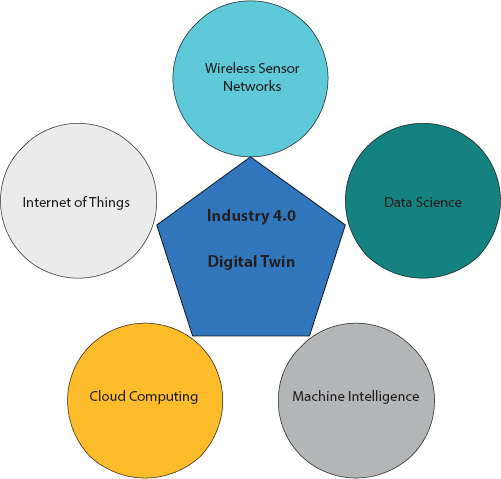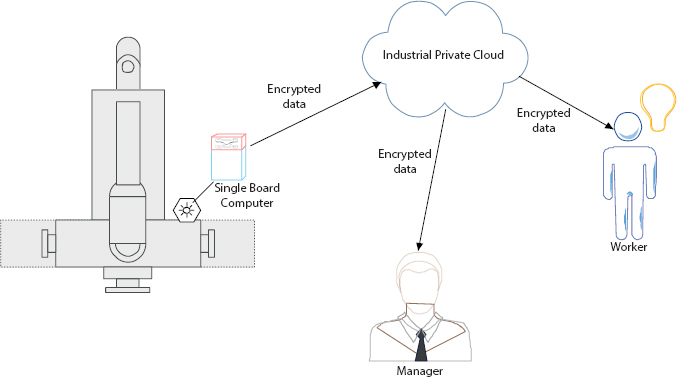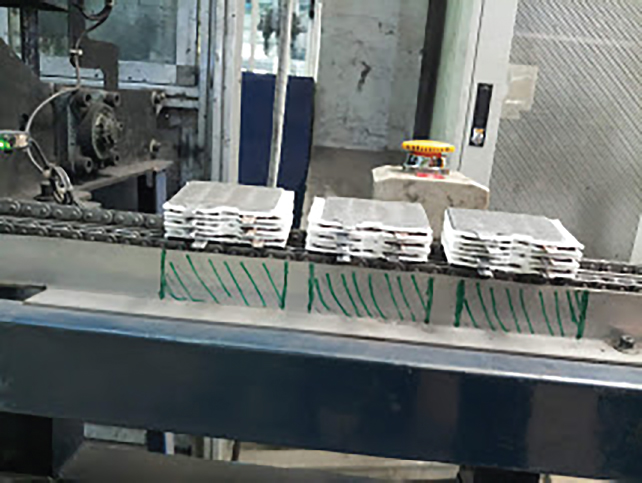4
Production Monitoring and Dashboard Design for Industry 4.0 Using Single-Board Computer (SBC)
Dineshbabu V.1*, Arul Kumar V. P.1† and Gowtham M. S.2‡
1Department of Information Technology, Karpagam Institute of Technology, Coimbatore, India
2Department of Electronics and Communication Engineering, Karpagam Institute of Technology, Coimbatore, India
Abstract
Industry 4.0 standard is presently enabled in all industrial sectors to enhance its production activity and to understand the nature of the machine health and to take better prognostics. The transformation of Industry 3.0 to 4.0 is critical due to old aged machinery and other security issues in the transformation. The single-board computers (SBCs) in the present market are capable to deliver the requested content from industrial machines and capable to satisfy the client requirement to switch over to Industry 4.0. This chapter envisages the dashboard design and monitoring of industry production activity with SBCs. This also discusses on architecture and role of machine intelligence in monitoring such events. A Raspberry Pi–based production monitoring system is designed with ultrasonic sensors, camera to catch up the event, and RFID to monitor the production activity. The artificial intelligence–based algorithm is incorporated to identify the faulty production orders in the lane. The computational complexity of the same is analyzed in this paper.
Keywords: Industry 4.0, single-board computers, image processing, system complexity
4.1 Introduction
Digital twin design and technology is the most important strategic trends in the modern Industry 4.0 standards. This methodology helps in better understanding the machinery and meeting industrial expectation. The digital twin technology provides better prognostics and care to the machines [1–4]. The virtual/digital representation of the physical industrial machines and process makes the engineers and researchers to easily predict the performance efficiency and characteristics. This methodology of monitoring, i.e., digital representations, is represented throughout the product lifecycle for simulation purposes. This approach capable to demonstrate and mimic the design changes, scenario on usage, and other environmental conditions. This also reduces the approach on reducing the development time and aids in increasing the quality of finalized products. Important developments in Internet of Things (IoT), data science, and artificial intelligence have made the possibility to propose new standards in manufacturing strategies [5–9]. The common objective of this Industry 4.0 digital twin modeling is to increase the productivity and enhance the lifetime of the machine with high production quality. The reach of smart interconnection and operability in physical and digital space creates more challenges in interfacing monitoring. Figure 4.1 illustrates the technologies aiding Industry 4.0 modeling opportunities.

Figure 4.1 Domain technologies aiding Industry 4.0.
Security, reliability, and fault tolerant are the most expected features in Industry 4.0 for better operation and production [10–13].
4.2 Related Works
Numerous researches on digital twin and smart factories manufacturing have come in recent days. The existing IDS are well suited in real time, and deployment in virtual domain creates more complexities. The challenges in security of IDS are defined in [6], in which light weight cryptography algorithms are mainly focused. The state machine replication through stochastic mathematical approach is described in detail in [14–16]. The assumption on fault-based state machine realization in many approaches. The article explains the important objective of digital design as health analysis and lifetime monitoring of equipment. Penetration-based testing is also done in [17–19] through Industry 4.0 which is more challenging in nature. The approach on state synchronization with IoT security was suggested in article [15]. This mainly covers only modeling and does not address the complete digital twin security frameworks. An autonomous ML and PLC middle attack was deeply discussed in article [17]. The input physical parameters are considered in passive replication problem modeling and purely based on physical world parameters.
4.3 Industry 4.0 Production and Dashboard Design
Remote production monitoring is the request from many of the production companies to the IoT engineers. The industrial expectation on IoT is really high and expects remote monitoring through intranet and secure data communication. This design is done through economical single-board computer (SBC) along with the node java scripting. The sensors used for monitoring is ultrasonic or laser-based light-depended resistors. The sensors used in the industries are normally 12 or 24 volts. A voltage divider circuit is designed to convert the sensor value as per the SBC power constraint. The AMS1117 IC in the board avoids increasing voltage and spikes due to industrial actions and safeguards the SBC. The SBCs are interfaced with the wireless network or existing wired infrastructure throughout the industries, so that the workers can able to see the production outcome anywhere within the industries. This happens with the secret key sharing and authentication mechanism. The data is secured through encryption algorithm. Figure 4.2 illustrates the proposed system architecture; key sharing is done through authenticated channel.

Figure 4.2 Industrial production monitoring system through IIoT.
Algorithm
Begin Process
Input from PLC controller is recorded in single-board computer; Share data to the industrial Cloud;
Once authentication is received share data to the concerned worker Data security through elliptic curve cryptography
End Process
4.4 Results and Discussion
The digital twin creation setup for a battery production monitoring system is created through the proposed architecture. Raspberry Pi–based SBC is used for monitoring the production process and the same is interfaced with the industrial internet. Figure 4.3 illustrates the battery production unit with anode-cathode plate’s assembly. The anode and cathode plates are assembled and moved for welding zones.

Figure 4.3 Production unit in industries.

Figure 4.4 Programming chart of digital twin creation.
The production monitoring dashboard design is done through Node. js scripting language in SBC. The SBC is connected with the network and can able to deploy remote GPIO and programming logic through network programming methodology. The production is verified and the status is updated within microsecond delay to the cloud environment. Figure 4.4 illustrates the digital twin creation using Node.js with gauge and dashboard design.

Figure 4.5 Digital twin design of production monitoring unit.

Figure 4.6 Network round trip delay time.
Figure 4.5 illustrates the application interface both monitor and android-based application design.
Figure 4.6 illustrates the minimum and maximum delay time to update the data in private cloud. The delay caused is due to various network traffic conditions inside the network.
4.5 Conclusion
A digital twin design is modeled through IoT SBCs. A battery manufacturing process is mimicked in thispaper. The data is also routed to the private cloud through securechannel. The sensor production to PLC circuitis tapped and programming is done to monitor the working of PLC logic. The time delay in uploading the data in the cloud is also calculated in this approach. The model is efficient and can be interfaced with any Industrial PLC circuits.
References
1. Tao, F., Zhang, L., Hu, Y.F., Resource service optimal-allocation system in MGrid, in: Resource Service Management in Manufacturing Grid System, pp. 27–41, Wiley, Hoboken, NJ, USA, 2012.
2. Kanagachidambaresan, G.R., Anand, R., Balasubramanian, E., Mahima, V., Internet of Things for Industry 4.0, EAI Springer, India, 10.1007/978-3-030-32530-5, 2020.
3. Tao, F., Zhang, L., Venkatesh, V.C., Luo, Y.L., Cheng, Y., Cloudmanufacturing: A computing and service-oriented manufacturing model. Inst. Mech. Eng., B, J. Eng. Manuf., 225, 10, 1969–1976, Aug. 2011.
4. Tao, F., Lai, Y., Li, L., Xu, Zhang, L., FC-PACO-RM: A parallel methodfor service composition optimal-selection in cloud manufacturing system. IEEE Trans. Industr. Inform., 9, 4, 2023–2033, Nov. 2013.
5. Tao, F., Zhang, M., Cheng, J., Digital twin workshop: A new paradigm for future workshop. Comput. Integr. Manuf. Syst., 23, 1, 1–9, 2017.
6. Monostori, L., Cyber-physical production systems: Roots, expectations and R&D challenges. Proc. CIRP, 17, 9–13, Jan. 2014.
7. Mourtzis, D., Vlachou, E., Milas, N., Xanthopoulos, N., A cloud-basedapproach for maintenance of machine tools and equipment based on shopfloor monitoring. Proc. CIRP, 41, 655–660, Jan. 2016.
8. Zhu, H.H., Gao, J., Li, D.B., Tang, D.B., A Web-based product servicesystem for aerospace maintenance, repair and overhaul services. Comput. Ind., 63, 4, 338–348, May 2012.
9. Hu, T.L., Li, P., Zhang, C.R., Liu, R.L., Design and application ofa real-time industrial Ethernet protocol under Linux using RTAI. Int. J. Comput. Integr. Manuf., 26, 5, 429–439, 2013.
10. Regulin, D., Glaese, A., Feldmann, S., Vogel-Heuser, B., Enablingflexible automation system hardware: Dynamic reconfiguration of a realtime capable field-bus, in: Proc. 13th Int. Conf. Ind. Informat., Cambridge, U.K., pp. 1198–1205, 2015.
11. Felser, M., Real time ethernet: Standardization and implementations, in: Proc. IEEE Int. Symp. Ind. Electron., Bari, Italy, Sep. 2010, pp. 3766–3771.
12. Cena, G., Bertolotti, I.C., Hu, T., Valenzano, A., Seamless integration of CAN in intranets. Comput. Stand. Interfaces, 46, 1–14, May 2016.
13. Sauter, T. and Lobashov, M., How to access factory floor information using Internet technologies and gateways. IEEE Trans. Industr. Inform., 7, 4, 671–699, Nov. 2011.
14. Mourtzis, D., Vlachou, E., Milas, N., Dimitrakopoulos, G., Energy consumption estimation for machining processes based on real-time shopfloor monitoring via wireless sensor networks. Proc. CIRP, 57, 637–642, Dec. 2016.
15. Liu, Q., Zhang, H., Wan, J., Chen, X., An access control model forresource sharing based on the role-based access control intended formulti-domain manufacturing Internet of Things. IEEE Access, 5, 7001–7011, Apr. 2017.
16. Zhang, Y.F., Zhang, G., Du, W., Wang, J.Q., Ali, E., Sun, S.D., An optimization method for shopfloor material handling based on realtime and multi-source manufacturing data. Int. J. Prod. Econ., 165, 3, 282–292, Jul. 2015.
17. Edrington, B., Zhao, B.Y., Hansel, A., Mori, M., Fujishima, M., Machine monitoring system based on MTConnect technology. Proc. CIRP, 22, 92–97, Dec. 2014.
18. Zarte, M., Pechmann, A., Wermann, J., Gosewehr, F., Colomboet, A.W., Building an Industry 4.0-compliant lab environment to demonstrate connectivity between shop floor and IT levels of an enterprise, in: Proc. 42th Annu. IEEE Ind. Electron. Soc. Conf., Oct. 2016, pp. 6590–6595.
19. Hoffmann, M., Büscher, C., Meisen, T., Jeschke, S., Continuous integration of field level production data into top-level information systems using the OPC interface standard. Proc. CIRP, 41, 496–501, Jan. 2016.
- *Corresponding author: [email protected]
- †Corresponding author: [email protected]
- ‡Corresponding author: [email protected]
